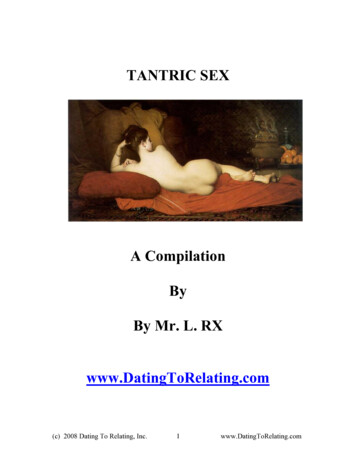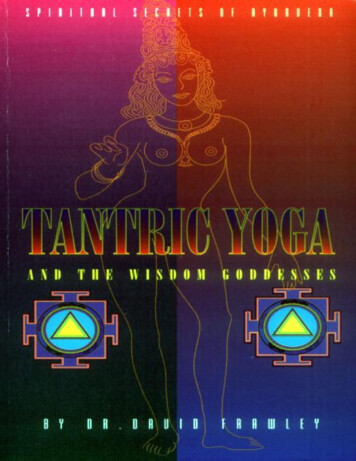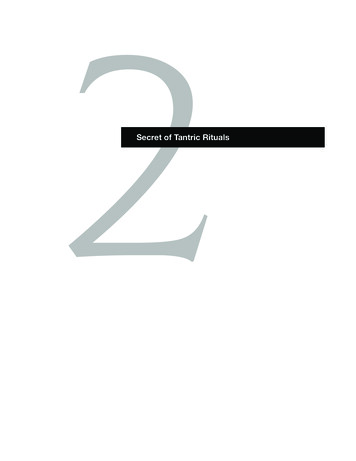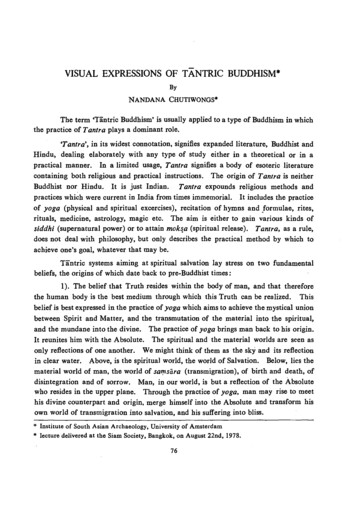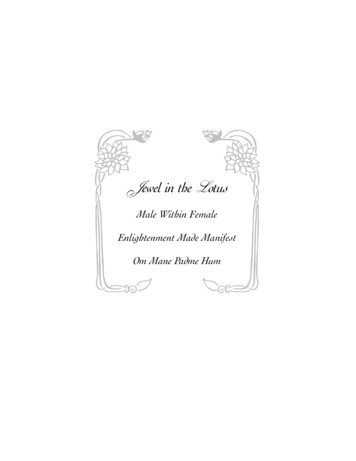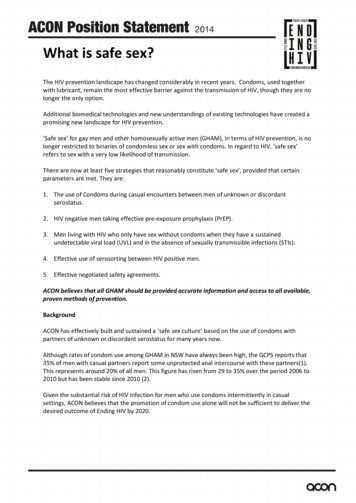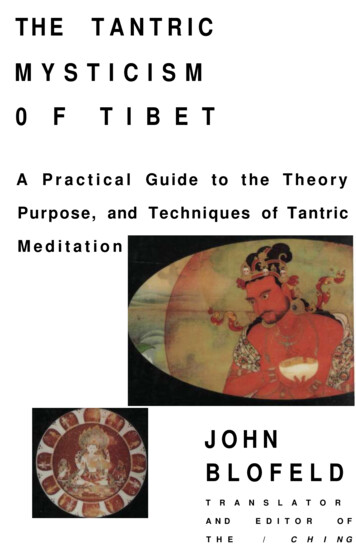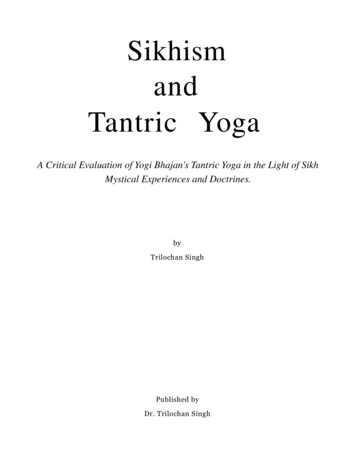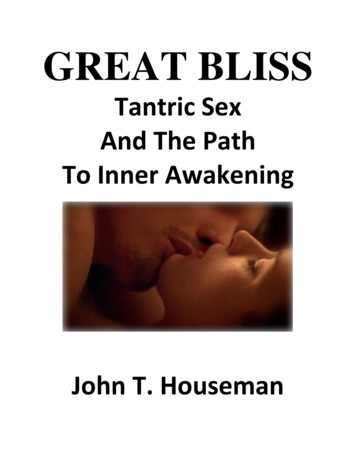
Transcription
GREAT BLISSTantric SexAnd The PathTo Inner AwakeningJohn T. Houseman
Great BlissTantric Sex and the PathTo Inner AwakeningJohn T. HousemanIAPInner Awakening Press2014
Inner Awakening Pressc/o John T. Houseman10600 North Kings HighwayMyrtle Beach, SC 29572Copyright 2014 by John T. HousemanNo rights reserved. All written material is freely given into the public domain.The author requests that any use of this material be given proper citation.Disclaimer: It is suggested that all exercises in this book be done in consultationwith your health care professional. In order to perform these practices you should be in goodphysical, emotional and mental health. The author, photographers and publisher cannot assumeany responsibility for injuries, damage or results of practice.Every effort has been made to obtain permissions for images in this work.If any required acknowledgements have been omitted, or any rights overlooked,it is unintentional. Please notify the publisher of any omission,and it will be rectified in future editions.The author warmly welcomes comments from readers.Suggestions will be incorporated in future editions of this book.
ContentsAbout the AuthoriAcknowledgementsiiiPronouncing SanskritvIntroduction. Juicy Buddhism: The Power of Sexual Yoga1Chapter 1. The Path of Renunciation: The Common Vehicle13Chapter 2. The Path of Purification: The Mahāyāna44Chapter 3. The Path of Transformation: The Vajrayāna78Chapter 4. Ready for Bliss: Consecration115Chapter 5. Sacred Outlook: Deity Yoga178Chapter 6. Inner Bliss: Subtle Energy Yoga206Chapter 7. Intimate Rapture: Sexual Yoga258Chapter 8. Embrace of the Beloved: Nondual Yoga323Chapter 9. The Sacred Site of Enlightenment: Preparing for Practice355Chapter 10. Revered by All the Yoginīs:The Sādhana of Secret Vajravilāsinī367Chapter 11. Inner Awakening: The Commentary toThe Sādhana of Secret Vajravilāsinī407Conclusion. The Paradise of the Yoginīs: The Tantric Lifestyle442Appendix: Buddhist Names447Notes449Bibliography482
About the AuthorI have devoted myself to Tantra for overthirty years. Trained as a lama, Icompleted an intensive, solitary three-yearmeditation retreat in the remote desertmountains of Arizona under the guidanceof the Tibetan Buddhist master HisEminence Garchen Rinpoche.At the age of nineteen, after two years ofmeditation practice, I had a profoundspiritual awakening and vowed to attainenlightenment in this lifetime. I was firsttaken by Tantric philosophy whilestudying Buddhism as a Religion major atWesleyan University, where I studied withthree highly regarded professors - RobertThurman, Janice Willis, and James Stone. I also received the university’s annual James A.Spurrier Award for distinction in ethics. I later earned a master’s degree from ColumbiaUniversity.I have been in the presence of thirty enlightened masters from among the world’s great spiritualtraditions. My early spiritual studies were eclectic – I spent time with many highly realizedbeings such as Brother David Steindl-Rast, Pir Vilayat Khan, Shri Chinmoy, Mother Meera, andThich Nhat Hanh. I also studied Tai Chi in New York City with master C. K. Chu. I attended theBarbara Brennan School of Healing for two years, where I learned the skills of energy healing. Iwas a client of John Pierrakos, MD, the founder of Core Energetics, a spiritual, body-centeredpsychotherapy. I learned channeling as a student of Diana Muenz for six years. In addition, Ireceived from her a two-year course in enlightenment from her spirit guides, and receivedteachings and intensive empowerments from many of the greatest spiritual masters of all time,including Jesus, Moses, the Buddha, and Quan Yin. I followed for several years a path of soulinitiations taught by Alice Bailey of the Theosophical Society and led by Robert Jaffe, MD. Ialso followed for five years a Sufi path to God realization called the Twenty-Eight Stations of theHeart with Railey Macey. I was a client of two incomparable energy healers, Mark Shoofs for ayear, and Nora Cooper, PhD, for three years. I have supported my spiritual path with numerousAyahuasca journeys, and a meditation practice spanning nearly thirty-five years.In the early 1990s, my focus shifted strongly towards Tantra. Seeking to understand itsexceptionally rich five thousand year history and countless traditions, I read over six hundredbooks on the subject – I uncovered a secret history of Tantra, virtually unknown to historians,and a secret philosophy of Tantric Buddhism, virtually unknown to Buddhists. I studiedtraditional Hindu kuṇḍalinī yoga with Swami Hridayananda in France, and received teachingsfrom Guru Mayi at Muktananda Ashram in South Fallsubrgh, New York. I also practiced haṭhayoga and studied Sanskrit and the Tantric philosophy of Kashmir Śaivism while living for a yearat Satchidananda Ashram in Buckingham, Virginia. From 1999-2001, I led the Tantra movement
in New York City, hosting monthly Tantra community gatherings, and practiced with nearlytwenty Western Tantra teachers including Margot Anand. Robert Frey and Lori Grace were myfirst Western Tantra teachers, who opened my eyes to the power of Tantric sex - through them Ifinally found my core path. The deep love of a few passionate Tantric yoginīs also helped me totransform what I knew of only as an enjoyable activity into something infinitely greater. Theirwisdom, love, and inspiration remains embedded in each page of this book. My Tantric consortfor seven years was Katya Salkinder, a highly regarded psychotherapist, yoga and Tantra teacher.I taught Western Tantra for several years in the Northeast. I also had the good fortune to be partof a wonderful and supportive Tantric community in Bethesda, Maryland for two years.But it is in Tantric Buddhism where Imade my home. I studied and practicedTantric Buddhism for four years as aresident of Karma Triyana Dharmachakramonastery in Woodstock, New York, theNorth American seat of His Holiness theSeventeenth Karmapa (in photo with theauthor). I have received teachings fromover fifteen Tibetan rinpoches, and morethanahundredTantricdeityempowerments. My outstanding teachersin deity yoga include Khenpo KartharRinpoche, Drupon Rinchen DorjeRinpoche, Garchen Rinpoche, and HisHoliness the Dalai Lama. In subtle energyyoga and the visualization practices ofsexual yoga, Drupon Rinchen DorjeRinpoche and Garchen Rinpoche havebeen supreme. In nondual yoga, myprecious guides for Mahāmudrā have beenKhenpo Karthar Rinpoche, ThranguRinpoche, Drupon Rinchen Dorje Rinpoche, Garchen Rinpoche, and Nubpa Rinpoche, as well asTraga Rinpoche for the Dzogchen traditions of Trekchö and Tögal.It has been my lifelong wish to give a great gift to the world. To be able to give the firstcomplete, modern instruction book on the original path of the Indian Tantric Buddhist siddhas,and the first on Buddhist sexual yoga, far exceeded my expectations. For the first time, modernreaders have all the information they need to attain enlightenment in a single lifetime. Thepractices in this book are proven to be the swiftest means of all, and I am determined to givethem to a world in suffering so that all beings may know the Great Bliss.
AcknowledgementsExceptional thanks should be given to the work of several scholars whose life efforts made thisbook possible. Keith Dowman’s classic Masters of Mahāmudrā first drew me into the world ofthe siddhas, but left me with two questions burning unanswered in my heart for nearly twentyyears – what was the original path of the Indian Tantric Buddhist masters, and how could Ifollow it? Miranda Shaw’s Passionate Enlightenment provided the critical groundwork in thephilosophy of Buddhist sexual yoga. Elizabeth English’s Vajrayoginī detailed the ritualfoundations for the Indian Tantric Buddhist tradition, and first brought to light the brilliantsādhana that would form the core of my book. She also graciously helped me to locate thepublished Sanskrit version of The Sādhana of Secret Vajravilāsinī at the Bodleian Library atOxford. Exceptionally good translations of the two most important Buddhist Tantras - theHevajra Tantra by G. W. Farrow and I. Menon, and the Cakrasamvara Tantra by David B. Gray- presented crucially important original source texts without which this book could not have beenwritten. The team of translators for Jamgön Kongtrul’s The Treasury of Knowledge should beespecially acknowledged – their massive, multi-volume work took decades to produce, andprovided a rich well of material on the unique positions of Tantric Buddhist philosophy, theconsecrations and vows, the Four Yogas, as well as many previously unknown practices ofsexual yoga taught by the Indian siddhas. This series, one of the great scholarly achievements ofthe past hundred years, will remain an enduring presentation of the transformative potential ofTantric Buddhism. All these pieces needed to be in place before I could write Great Bliss.Great Bliss took six years to write, and I had much to learn along the way. Once I began, TragaRinpoche was extremely generous with his time, clarifying many key Dharma points ofphilosophy and practice – and gave me a mind transmission that left me staggering out of theroom. He especially stressed to me the value of love as equal in importance to compassion inBuddhism, a precious teaching for which I remain intensely grateful.Two translators offered their superlative assistance and aided me in the translation of thesādhana, Suzanne Ironbiter, Professor of Religion at SUNY Purchase, and Amrita Nadi Osborne,senior staff member at Karma Triyana Dharmacakra monastery in Woodstock, New York.Numerous readers were very helpful in finalizing the text, and to whom I give thanks.I want to thank also the staff at the Library of Congress, where I spent a month in research, aswell as the always helpful staff at the New York Public Library, where I spent two months.Many line illustrations from this book come from Robert Beer’s Handbook of Tibetan BuddhistSymbols published by Shambhala.
For those readers concerned about the traditions of secrecy in Tantric Buddhism, please note thatall exercises in this book come from previously published sources, and no still secret teachings ofany living Tantric lineages are being revealed. The need for secrecy was originally maintainedby the siddhas out of concern that these practices would be used for black magic, which wasrampant in the ancient and medieval worlds. Today the greatest concern is not black magic butthat these practices will be lost forever. Therefore, the greater merit comes to those who publishand preserve these practices rather than those who keep them secret and risk their permanentloss. Texts also have a way of protecting themselves, and I am confident that this book willremain in the hands of those who will use it to truly benefit themselves and others.
Pronouncing SanskritSanskrit is a very beautiful language, and holds within its vibrations a sacred energy that willgreatly empower your spiritual growth. It is easy to pronounce once you learn a few basic rules.Vowelsa – Short “a” as in “cut.”ā – Long “a” as in “lot.”i – As in “king,” a sound between “lick” and “keen.”ī – Hard “e” as in “keen.”u – Short u as in “cook.”ū – Long u as in “shoot.”Dipthongs:e – As in “bay.”ai –As in “eye.”ṛ – Trilled “r” followed by a short “I” as in “ri.”ṝ – Pronounced as above, but longer.ḷ – L followed by a short “i” as in “li.”o – As in “low.”au – As in “ouch.”Vowels with a line on top are pronounced twice as long as short vowels, and they are stressed syllables ina word.ConsonantsGutturals (made with the tip of the tongue at the back of the throat): k, kh, g, gh, ṅ.Palatals (made with the tongue at the palate): c, ch, j, jh, ñ.Cerebrals (made with the tip of the tongue behind the palate): ṭ, ṭh, ḍ, ḍh, ṇ.Dentals (made with the tip of the tongue behind the teeth): t, th, d, dh, n.Labials (made with the lips): p, ph, b, bh, m.Semivowels: y, r, l, v.Spirants: ś, ṣ, s, h.Other: ḥ, ṃ.Aspirated Letters:All consonants with an “h” after them are aspirated and pronounced separate from each other; ex. “gh” asin “dog house.”Cs:c – A “ch” as in “chopper.”Ns:ṅ – A “ng” as in “song;” ex. aliṅgana, pronounced “aling-gana,” not “alin-gana.”ñ – A “nya.”ṇ – A “n” with the tip of the tongue on the back of the throat.Spirants:ś – An “sh” as in “shoe.”ṣ – An “sh” with the tip of the tongue on the upper back part of the throat.Other Consonants:ḥ – A soft “h” that softly repeats the sound of the vowel before it, but is usually left as just a soft “h.”ṃ – A deeper, nasalized, longer and more resonant “m.”Consonant Combinations:Consonant combinations pronounced separately; ex. “th” pronounced like “hot house.”jñ – A “nya;” ex. prajñā, pronounced “pra-nya.”Apostrophes:’ – An elision of a vowel that is unpronounced, like a contraction; ex. “can’t.”
Syllable Stresses:In a two syllable word, the first syllable is usually stressed; ex. bali.In a three syllable word, the second syllable is usually stressed; ex. baliṅgtaIn a four syllable word, the second syllable is usually stressed; ex. narteśvara.If a word has a long vowel in it, the long vowel is stressed; ex. mudrā.If a word has two or more long vowels in it, all the long vowels are stressed; ex. Mahāmudrā.Nasalization:All words in Sanskrit are pronounced with a slight nasal tone.Note on formatting: Since this is a book for practitioners, many of whom will not be familiarwith Sanskrit, for ease of pronunciation most compounded words have been broken up, andexcept in the sādhana, a letter “i” has been inserted after the Sanskrit letter “ṛ.”
Introduction.Juicy Buddhism:The Power of Sexual Yoga“Buddhahood is obtained from bliss,and apart from women there will not be bliss.”- Caṇḍamahāroṣaṇa TantraPraise to Vajravilāsinī, goddess of eternal love!The Practice Begins AgainIndia,800CE:Twopractitioners, students of thegreat master Śabara, entered abeautiful pleasure garden tobegin their practice. Thegarden was filled with cuckoobirds, bright flowers, and tallaśoka trees bursting with redblossoms. It was the night ofthe Full Moon, and a cloudlesssky bathed them in a gentlelight. They had already takenhot baths and received sesameoil massages from theirfriends, and their naked bodiesglistened in the moonlight.With the air still warm fromthe heat of the day, they wereembraced by the lush forests ofOḍra.Their devoted practice was TheSādhanaofSecretVajravilāsinī. Clear in theirdeterminationtoattainenlightenment and liberate allbeings from suffering, thepractice began with a bow inheartfelt reverence to eachother. They recited the openingverses together, which they had long ago memorized by heart. Viewing each other as god andgoddess, he touched her body pleasurably with his hands, and they kissed each other with risingpassion. And now, hundreds of years later, the practice begins again.1
The Power of Inner Awakening“Let your heart unite with my heart.”- The Ṛig Veda, Ancient IndiaYou can live permanently in peace and bliss. Calm and relaxed, joyful and carefree, yet chargedwith energy and enthusiasm. You can possess clarity of mind, profound wisdom, kindness andunderstanding toward everyone you meet. Radiating love, you can feel complete fulfillmentthrough your relationships. Fully open to the pleasures of life, you can create what you desire.All this can be yours, in this very lifetime. And you can use these inner qualities to help bringothers to the same bliss as well.Enlightenment, the highest goal of all spiritual paths, is truly possible for you. While mostspiritual paths require great hardship, you can follow a path of intense pleasure. You can havemore fun than you ever had before, and find yourself growing in love and joy each day. Thisbook shows you how. The practices are so enjoyable, you will want to do them again and again.These methods are not new. In fact, they come from the oldest spiritual tradition in the world.They have just been hidden for a very long time.Tantra: The Primordial Path“If you wish to see the nature of the divine mystery, consider the marvelous imageof sexual intercourse. At the moment when the male reaches his climax,the female receives the strength of the male and the male the strength of the female.These are holy mysteries to be reflected upon and acted out.”– The Perfect Discourse, Ancient EgyptThe path to bliss is bliss. That is the path and goal of Tantra. Tantra is the path of becomingwhole through pleasure. It awakens your senses to reveal the sacred in all of life. As youpractice, you break out of all the restrictions that have been your safe, boring shell, and expand tothe fullness of your true being. The only rules in Tantra are to open to life, drench yourself withits pleasures, and rise again and again to the peak of your ecstatic true being until you and theuniverse are one. When there is no separation between you and All That Is, then you are free.You become the primordial bliss that is your birthright. Once you attain this bliss, it is eternal.The word “Tantra” comes from the Sanskrit root word “Tan” which means “to weave.” Tantraweaves together seemingly opposing energies (such as female and male, sex and spirit) to createwholeness, health and happiness. You weave or unite into your entire being breath with spirit,your own daily life with the sacred power of ultimate reality. The result is eternal peace andbliss. The Guhyasamāja Tantra (The Secret Assembly Tantra) defines Tantra as “continuum,”the ability to maintain continually the awareness of the dynamic unity of all experiences. It is thesimultaneous awareness of oceanic clarity and stillness with pulsing, exultant aliveness, therelease of all your limiting beliefs and emotional afflictions, the sexual ecstasy you alwaysdreamed of, and the power to fulfill your heart’s desires, also called Great Bliss.2
The Tantras, divinely revealed texts from medieval India, teach the secrets to attaining oceanicbliss very rapidly. The central principle of their teachings is: everything is sacred. And the pathof Tantra is: embrace everything. In the Tantric view, any spiritual path that rejects the pleasuresof this world is incomplete – a dishonoring of the gift that life truly is. Whatever you love aboutlife, Tantra wants you to have that experience even more. Tantra is the most fun you can have inthe universe. It is the ultimate act of being alive, and the ultimate gift you can give to others.Nothing is or could ever possibly be better than Tantra.The Secret History of Tantra“My god, sweet is the drink of the wine-maid,like her drink sweet is her vulva, sweet is her drink,like her lips sweet is her vulva, sweet is her drink,sweet is her mixed drink, her drink.”- The Sacred Marriage Rite, Ancient SumerTantra is the world’s oldest spiritual path, yet it remains one of history’s greatest untold stories.For thousands of years, human beings have used pleasure, and specifically sexual pleasure, togain the divine powers of the gods. From the time when people first began to develop a spiritualoutlook, Tantra emerged, and its themes and practices are so compelling and enduring thatTantra has influenced every major religion in the world.About 150,000 years ago, the first humans moved across Africa, Europe and Asia, livingauthentically, passionately, erotically and spiritually. They honored the sacredness of their worldwith their bodies, emotions, minds and hearts fully open, to the awesome powers of nature, andto each other, celebrating in awe and delight each moment of their lives. They lived in peace andharmony with their world in a holistic consciousness that saw life and spirit as one. From theseroots, Tantra as the path of uniting sex and spirit emerged as a natural expression of the essenceof human existence. Tantra is not a set of ideas like a religion that some person once thought oflong ago. Tantra is built into you. It is a potential within you to realize.The earliest peoples knew that through uniting sex with spirit they could be transformed intohigher beings. The oldest written evidence for Tantra comes from the world’s oldest story, theSumerian tale The Epic of Gilgamesh, which dates to around 2800 BCE, and speaks of timelesswisdom. In this story, the wild man Enkidu spends several days making love to a Sumerianpriestess (often pejoratively translated as “sacred prostitute”), after which he becomes “like agod.” In India, the Harappans (6000 BCE to 1800 BCE) participated in ecstatic sacred sex ritualsusing sacred ring stones and liṅgaṃs - the ancient origins of the religions of the divine femaleprinciple (Śakti) alongside the worship of the eternal male principle (Śiva).The blissful harmony of early humans was ultimately shattered by catastrophic shifts in the wayspeople lived their lives. The original integrated consciousness that saw life and spirit as one waslost. Beginning around 3000 BCE, following the intensive adoption of farming and herding, newconcepts like private property arose, which threw human beings out of their holistic world view.Land, animals, and even human beings became identified as objects to be exploited. Farmers3
needed more children to tend their fields, and marriage was stressed as a moral virtue so that menwould gain the sole economic benefits of their many offspring. For women to produce morechildren, the age-old practice of weaning them was shortened from three to four years to abouteighteen months. Corporal punishment became the standard for child-rearing. These changesresulted in children growing into anxious, insecure adults - an inner lack searching for an everelusive wholeness.Once people gained greater material wealth, it had to be protected from greedy neighbors. Withthe development of metals, weapons became more lethal than ever. The terror of war began todominate the landscape, creating devastating suffering. The invention of writing, which alsooccurred around 3000 BCE, further shifted human consciousness out of the original balancedharmony of awareness. Holistic thinking was replaced by linear, rational thought, a strongsubject-object division of experience, and people were compelled emotionally toward controllingothers rather than delighting in being their equals. This relentless process occurred acrosscultures over a period of several thousand years as human beings became progressively moreimbalanced and ultimately insane. What we call the “story of civilization” is principally the storyof what human beings do when they lack inner contentment and self-love. These events thatbegan five thousand years ago continue to shape how most people live their lives today.The final shift in human life in ancient times was spiritual. Beginning after 2000 BCE, theworld’s religions faced what the historian Joseph Campbell called the “Great Reversal.” Theearliest myths point to life on earth as fundamentally good, worthy of sacred celebration. Yet lifehad become so drenched in misery that these myths could no longer speak to people. New mythsarose that describe life on earth as inherently dangerous and filled with suffering, and teach thatthe only way to find lasting happiness is to escape from it permanently. In the West the conceptof Original Sin took ground, while in the East humans were believed to have entered the KaliYuga - the Age of Strife or degeneracy.In India, the hymns called the Vedas (Songs) expressed much of the pre-Great Reversalenthusiasm for the sacredness of life. The Vedic religion was a Tantric tradition whose priestsmade offerings to the abiding spirits of nature, organized their rituals to the polar elements of fireand water (united in the spiritually empowering soma drink), and participated in group sacredsex rituals. The earliest known Tantric sect, the Vratyas, is described in the Atharva Veda (TheSongs of Atharva), which tells of worship of ecstatic gods, sacred sex rituals and kuṇḍalinī yoga.Starting around the time of the Upaniṣads (The Wisdom of Sitting Near; c. 800-400 BCE),however, much of Indian religion reflects an unprecedented new principle that following thesacred path means rejecting life. Life on earth is viewed as a tragedy and a trap from which ahuman soul can only seek to escape. The Sāṃkhya (Enumeration) and Yoga (Union)philosophies both consider that the human soul is imprisoned in the world, therefore their goal isliberation from the world. Pleasure only further enmeshes you in the sinkhole of life; asceticdetachment, they say, leads to liberation and eternal happiness.In response to the intense suffering of so many people around the world, an era of reformmovements known as the Axial Age (c. 800 BCE - 200 BCE) rose. The many leaders of this Age(such as Plato, Zoroaster, the Jewish prophets, Mahāvīra, the Buddha, Confucius, and others)4
accepted the belief of their time that life is inherently suffering, and taught that the only true pathto happiness is to reach an other-worldly paradise. They rejected worldly pleasures as leading tohell, and rejected anything Tantric as an especially fast path to hell. The leaders of the Axial Ageestablished the religious language and concerns that guide the world’s major religions today.Tantra was once integral to all the ancient Eurasian civilizations. From the temple prostitutes ofBabylon to the Greek mystery schools, from the Celtic spring festivals to the Gnostic Christiansand the royal palaces of China, the idea that sexual pleasure led to inner transformation was anaccepted fact. Following the guidance of the Axial Age leaders, however, almost everywhere theTantric traditions that celebrated life were wiped out.The Buddha, like other Axial Age teachers, taught that people suffer because of their neverending desire for sensual pleasures. He found that although it is possible to find limitedhappiness in this world, because of the impermanence of everything in it, the immutable laws ofkarma, and the unending cycle of wandering in suffering he called saṃsāra, this world remainsintrinsically dangerous. By renouncing the world, cutting yourself off from desire and sensepleasures, and pulling your awareness inwards through meditation, you can release yourself fromyour bonds and attain everlasting peace and bliss. After death, as a liberated being, you willnever again have to face the suffering of life on earth. Although the Buddha taught the sameworld-denying message as other leaders of his era to his monks, remarkably, he taught adramatically different message to his lay followers that is far less well known to modern people:to enjoy worldly pleasures responsibly. This “radical” idea produced two extraordinary results.First, of all the teachers of the Axial Age, the Buddha was the only one who actually establisheda successful record of bringing more peaceful lives to his followers. And second, it created a rareopportunity for something even greater to emerge – in time, from within the core of theBuddha’s own teachings, an extraordinary Tantric tradition once again affirming the sacrednessof life and its potential for bliss was eventually born.Because of the enduring influence of tribal cultures on Indian civilization, Tantric ways remainedstrong in India even as they nearly died out in Europe and much of Asia. Beginning around the400s CE, a richly Tantric Hindu culture flowered, and it eventually influenced Buddhism.Beginning around the 700s CE, India’s masters of Tantric Buddhism, the siddhas (accomplishedones), taught a very different path and goal than those first taught by the Buddha. All beings thatare not enlightened are in suffering – the siddhas strongly affirmed this position. But the realenemy, they taught, is not desire, but craving or compulsive desire – also called attachment. Puredesires, and especially strong ones, can not only be enjoyed for their own sake, but can also beused to propel you to inner awakening. And the best path for achieving that awakening is notthrough renouncing the world but through intense pleasure, love, and bliss.The siddhas taught that the world is not inherently suffering – it is only your falsemisconceptions that make it seem so. Once you are released from suffering, this precious worldbecomes a paradise. They rejected the central message of the Axial Age leaders that hypnotizedthe world and reaffirmed the original, primordial vision of human beings of the sacredness oflife, pleasure, and sexuality. Tantric Buddhism praises life on earth as inherently good andpleasurable, and all pure desires are to be enjoyed.5
Tantric Buddhism is mainly known in the West today in its form as Tibetan Buddhism. TibetanBuddhism is one of the world’s most successful systems for spiritual transformation, and isbecoming increasingly popular in the West. As Tantric Buddhism first came to Tibet from the700s to 1200s, it was largely identical to its practices in India, but over time the Tibetanschanged it. The greatest difference between the two traditions is in the role of sexual yoga. Thegreat Indian masters who founded the major lineages of Tibetan Tantric Buddhism,Padmasambhava (c. late 700s), Virūpa (c. 800s), Tilopa (988-1069), and Atīśa (980-1054),understood sexual yoga as central for liberation. Yet most later Tibetans moved away fromsexual yoga as a core practice. In addition, many Tibetan teachers rejected the life-embracingphilosophy of the Tantric siddhas, and returned to an earlier life-negating message found in thesūtras that life on earth is inherently dangerous and sensual pleasures should be avoided.Tibetan Buddhism is to a great extent a dis-integrated form of Indian Tantric Buddhism. AllTibetan lineages affirm in principle that sexual yoga is necessary to attain enlightenment, and thereverence for the Indian masters and early Tibetan masters who practiced sexual yoga is high.But the monastic establishment reshaped Tantric Buddhism to suit their needs. As a result, mostTibetan lineages do not practice the original Tantric Buddh
My Tantric consort for seven years was Katya Salkinder, a highly regarded psychotherapist, yoga and Tantra teacher. I taught Western Tantra for several years in the Northeast. I also had the good fortune to be part of a wonderful and supportive Tantric community in Bethesda, Maryland for two years. But it is in Tantric Buddhism where I


